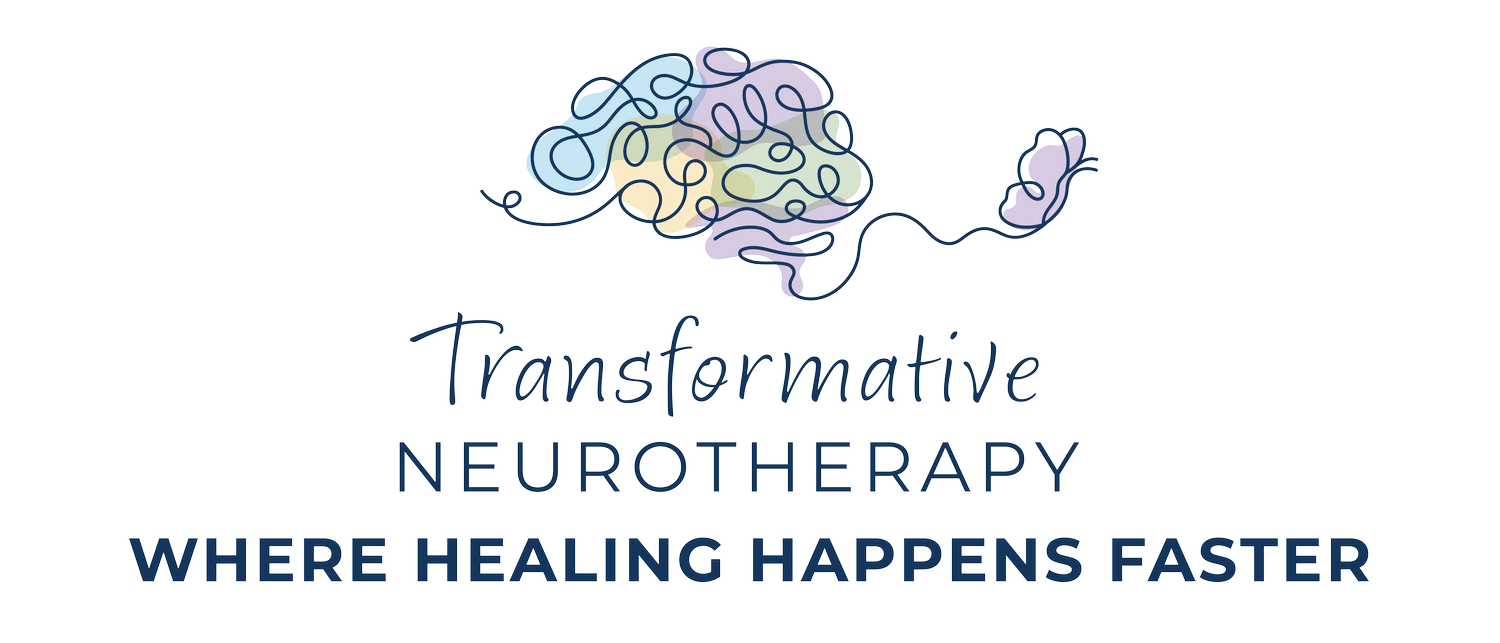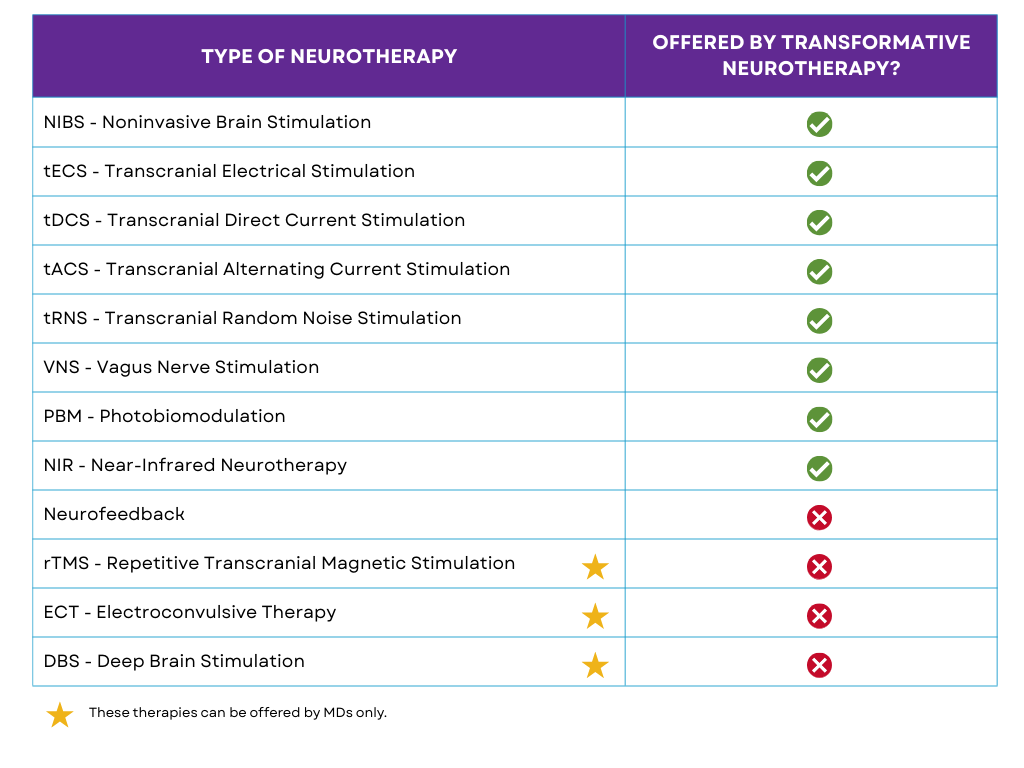SAFETY OF NEUROTHERAPY
Safety sits at the center of every brain-based therapy we offer—and for good reason. No one wants to trade risk for results. Our goal is to help clients feel confident that neuromodulation can be both gentle and effective when guided by science, dosing limits, and careful protocols.
At Transformative Neurotherapy, we work with three primary approaches: photobiomodulation (light therapy), pulsed electromagnetic field (PEMF), and low-intensity electrical stimulation. Each interacts with the nervous system in a unique way, but the throughline is precision. Targeted wavelengths, tuned magnetic frequencies, and controlled current keep interventions within a safety envelope supported by research.
In this video, Dr. Heather Putney explains how neurotherapy can be both gentle and effective when guided by research, conservative dosing, and individualized care.
From photobiomodulation (light therapy) to pulsed electromagnetic field (PEMF) and low-intensity electrical stimulation, Dr. Putney discusses how each approach interacts with the nervous system—and why safety isn’t a checkbox, it’s a method.
Whether you’re managing brain fog, anxiety, post-COVID fatigue, or simply curious about peak performance, the key is understanding both mechanism and dose. That’s where we begin—with education, calibration, and a commitment to listening to the body’s feedback. You might also scroll down to review the research into the safety of Neurotherapy modalities.
Light Therapy (Photobiomodulation)
Light therapy uses specific wavelengths and intensities shown to support mitochondrial function, cerebral blood flow, and neuroplasticity. When applied to targeted regions, it can help with cognitive decline, mood disorders, and post-viral brain fog. The most common side effect is warmth on the skin, which is expected and easily managed by adjusting intensity or placement. Because it’s noninvasive and well studied, many people feel comfortable starting here. We tailor frequency and pulsing to match individual goals—alerting when needed or soothing for evening sessions. For those concerned about overstimulation, we begin with low settings and observe response patterns between visits to fine-tune exposure.
Pulsed Electromagnetic Field (PEMF)
PEMF builds on the idea that electromagnetic fields can be either disruptive or restorative depending on frequency, waveform, and amplitude. Using low-intensity coils, we deliver frequencies designed to resonate with the body. One of our most effective protocols targets systemic inflammation, often placing coils at the gut to influence the gut–brain axis. Reducing peripheral inflammation can calm neuroinflammation and improve focus and emotional regulation.
The origin story of PEMF is compelling: a developer seeking a safe way to stimulate a newborn’s brain after hypoxia needed a modality gentle enough for a fragile nervous system. That constraint shaped PEMF into a therapy that is subtle, quiet, and often unfelt, yet supportive of oxygenation and circulation. Clinical use has expanded, but the safety-first roots remain.
Low-Intensity Electrical Stimulation
Electrical stimulation is the modality people question most, yet it’s also the most controlled. Compared with consumer TENS units that may run from 0 to 80–100 mA on the body, transcranial direct current stimulation (tDCS) in clinics operates at much lower levels. A meta-analysis of 158 studies, totaling more than 4,000 participants, reported no serious adverse effects within parameters: up to 4 mA and 40 minutes per session. Typical side effects were mild skin redness or irritation at electrode sites.
Our practice is even more conservative. We titrate from 0.001 to 2.5 mA and observe responses in real time. We start low, increase gradually if tolerated, and stop at the lowest effective dose. Think of it like medication titration: begin with microdoses, earn the next step with clear benefit and comfort, and cap at safe ceilings.
Safety Across Populations
Parents often ask whether these protocols are suitable for children or other vulnerable groups. The evidence base includes women, children, older adults, and some pregnant populations, with no elevated risks reported when operating inside established limits. While fewer studies focus exclusively on these groups, our clinical experience aligns with the data: when titrated thoughtfully, children with ADHD, sensory differences, or autism can experience better focus, improved executive function, and steadier emotions. Families often report calmer evenings and better sleep, which amplifies gains during the day.
For adults seeking peak performance, short alerting protocols in gamma ranges can feel like a clean cup of coffee—more clarity without jitter. Sleep quality often improves after sessions, a reliable sign that the nervous system is settling rather than being overstressed.
Safety isn’t a checkbox - it’s a method.
Safety isn’t a checkbox—it’s a method. We begin with the best information available, which is why every treatment plan starts with a recent EEG. Objective brain data allows us to see patterns that symptoms alone can’t fully explain. We define the target, choose the modality that best fits the goal, set conservative parameters, and listen to the body’s feedback. By integrating light, PEMF, and electrical stimulation with measured dosing and individualized placement, we help the brain do what it’s built to do: adapt. Whether the aim is recovery from brain fog, relief from chronic stress, or a sharper edge at work, the safest path remains the smartest path—start low, go slow, personalize, and verify progress through sleep, mood, focus, and function.
SAFE NEUROTHERAPY FOR EVERY BRAIN.
Research on Safety in Neurotherapy
This page provides a curated selection of scientific research exploring the safety of neurotherapy techniques, including neurostimulation, photobiomodulation (PBM), and pulsed electromagnetic field (PEMF) therapies. These non-invasive approaches have been studied for their effects on brain function and overall well-being, with growing evidence supporting their safety profiles when used appropriately.
Each study included below contributes to the broader understanding of how these modalities influence neural activity, regulation, and repair while maintaining favorable risk profiles. Collectively, the findings demonstrate that when guided by clinical expertise, individualized protocols, and conservative dosing, neurotherapy interventions can offer measurable benefits with minimal side effects.
The following are a few key research studies on the safety of neurotherapy.
Laurin, A., Nard, N., Dalmont, M., Bulteau, S., Bénard, C., Bonnot, O., Winer, N., Dupont, F., Apter, G., Terranova-Commessie, F., Guillin, O., El-Hage, W., Sauvaget, A., & Rothärmel, M. (2022). Efficacy and Safety of Transcranial Electric Stimulation during the Perinatal Period: A Systematic Literature Review and Three Case Reports. Journal of Clinical Medicine, 11(14), 4048. https://doi.org/10.3390/jcm11144048
Rivera-Urbina, G., Nitsche, M., Vicario, C. & Molero-Chamizo, A. (2017). Applications of transcranial direct current stimulation in children and pediatrics. Reviews in the Neurosciences, 28(2), 173-184. https://doi.org/10.1515/revneuro-2016-0045
E. Zewdie, P. Ciechanski, H.C. Kuo, A. Giuffre, C. Kahl, R. King, L. Cole, H. Godfrey, T. Seeger, R. Swansburg, O. Damji, T. Rajapakse, J. Hodge, S. Nelson, B. Selby, L. Gan, Z. Jadavji, J.R. Larson, F. MacMaster, J.F. Yang, K. Barlow, M. Gorassini, K. Brunton, A. Kirton. (2020). Safety and tolerability of transcranial magnetic and direct current stimulation in children: Prospective single center evidence from 3.5 million stimulations, Brain Stimulation, Volume 13, Issue 3, 2020, Pages 565-575, ISSN 1935-861X, https://doi.org/10.1016/j.brs.2019.12.025.
Nikolin, S., Huggins, C., Martin, D., Alonzo, A., & Loo, C. K. (2018). Safety of repeated sessions of transcranial direct current stimulation: A systematic review. Brain Stimulation, 11(2), 278-288. https://doi.org/10.1016/j.brs.2017.10.020
Matsumoto, H., & Ugawa, Y. (2016). Adverse events of tDCS and tACS: A review. Clinical neurophysiology practice, 2, 19–25. https://doi.org/10.1016/j.cnp.2016.12.003
What Neurotherapy treatments does Transformative Neurotherapy offer?
“Neurotherapy” or “Neuromodulation” is a broad term for a number of different types of treatment options. We’ve outlined below what Transformative Neurotherapy does and does not currently offer.


